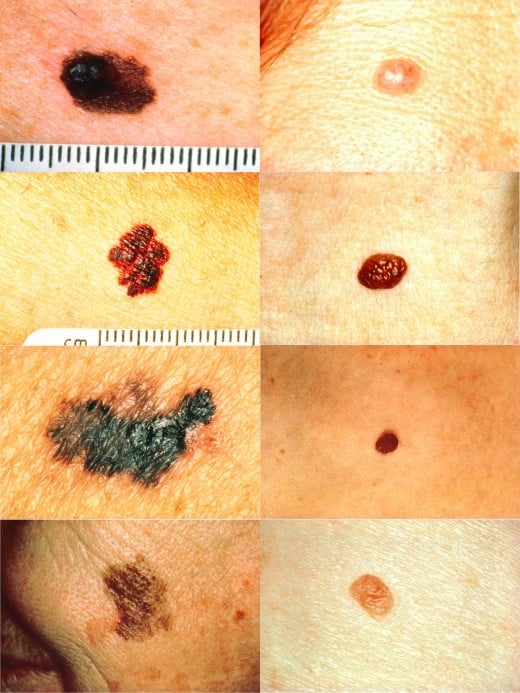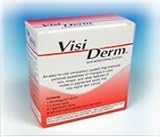Skin Cancer Prevention Information
What Is Skin Cancer?
Skin cancer, like other cancers, is an uncontrolled growth of cells. Skin cancer is the most common form of cancer; over 2 million new cases were detected in the U.S. alone in 2010 and its occurrence is rising in all races.
Although skin cancer is most often found on skin exposed to the sun, it also occurs in other areas. There are three major types of skin cancer: basal cell, squamous cell and melanoma.

Skin Cancer Prevention-Ultraviolet Light
The number one method of preventing skin cancer is to avoid exposing your skin to the ultraviolet rays of the sun. Whether you do this through the use of clothing and hats covering your skin or the use of sunscreens makes little difference, but it is important to do every season of the year.
It's easy to discount effects of the sun on your skin when the weather is cold and frosty, but those rays of sunshine are no less efficient at exposing you to their ultraviolet rays than in the warmer months.
The use of tanning beds and tanning lights also expose your skin to harmful ultraviolet radiation.
The American Cancer Society explains the three types of ultraviolet rays and the potential for damage each type can do: UVA rays cause your skin to age and wrinkle and may damage DNA in cells and are thought to be a cause of skin cancer. UVB rays directly damage DNA in cells and are the rays responsible for sunburns. These rays have been linked to most skin cancers. UVC rays are unable to penetrate our atmosphere and are not usually a cause of skin cancer.
Nothing protects you completely from all the UV rays of the sun. A darker, more tightly woven material in clothes affords more protection than lighter colors and lighter weight materials. If you can see through the fabric, the UV rays can penetrate it.
The clothing market now offers some clothes that have been specially treated to block UV rays. Additionally, there are now products that you can use in the laundry that afford greater UV protection to clothing washed in them.
Wear sunglasses to protect both your eyes and the delicate skin around your eyes from the harmful effects of the sun.
The American Academy of Dermatology and the American Cancer Society recommend using a sunscreen with a SPF factor of at least 30. The higher the SPF factor, the more protection from UV rays, but not sunscreen protects 100 percent.
Sunscreen should be applied thickly and re-applied often--every 2 hours for most sunscreens. One ounce--or a palmful--of sunscreen should be used to cover an adult's arms, legs, face and neck. Don't neglect the outside of your ears.
Skin Cancer Prevention Risk Factors
Although all races and skins types develop skin cancer, light-skinned people are more prone to skin damage from the sun. Light skin burns more easily than dark skin because there is less melanin in the skin. Melanin, which produces skin pigment, offers some protection against UV rays. And light skin burns more easily from the sun; sunburns are thought to be one of the causes of melanomas.
People with a family history of skin cancer are more likely to develop the condition than those people without such a history.
People with a large amount of moles, irregular or large moles may be more apt to develop skin cancer due to UV ray exposure.
If you live or vacation at high altitudes, your risk of radiation from UV rays is higher than those who do not.
Certain autoimmune disorders make people more vulnerable to the harmful effects of the sun, such as lupus.
A variety of medications increase your vulnerability to develop skin cancer: Birth control pills, tetracyclines, some non-steroidal anti-inflammatory drugs such as naproxen, phenothiazines and triclyclic antidepressants. Ask your health care provider or pharmacist if any of the medication you are taking causes increased photosensitivity (more prone to the negative effects of UV rays).
A Hubber Shares Her Personal Experience
- The Mohs Procedure That Is Used To Remove Basal Cell Carcinoma
Dr. Frederic E. Mohs developed the procedure for removing Basal Cell Carcinoma in 1936. It is widely used now by Dermatologists. I think by now everyone is aware that chronic exposure to the sunlight is the leading cause of Basal Cell Carcinoma. This
Important Skin Cancer Facts
Skin Cancer Prevention: What You Can Do
The American Cancer Society recommends checking your skin once a month to detect any changes in moles, blemishes or freckles. In this way, you'll be able to detect when new discolorations or suspicious spots. Changes in moles or other skis areas such as an increase in size, bleeding, change in shape or texture should be reported to your health care provider as soon as possible.
Early detection is as important as prevention when it comes to skin cancer.
Once a year, during your routine check-up or during a visit with a dermatologist, have your skin examined thoroughly for skin cancer. If you are in one of the high-risk groups to develop skin cancer, talk with your health care provider to determine if more frequent examinations of your skin are warranted.
One in five Americans are projected to develop skin cancer during their lifetime; don't be that one. Think prevention, then early detection.
Authoritative skin cancer resources: American Cancer Society
More Skin Cancer Information
- Prevent Skin Cancer: Best Tips for Sun Protection
That bottle of Coppertone is not enough to protect yourself from sun damage or skin cancer. Here's a useful guide to protect your skin every day. Hint: Sunblock is not the only answer. - The Skin Cancer Facts
This article give the facts and treatments about basal cell, squamous cell and melanoma skin cancers. It covers introcular melanoma. Cancer prevention guidelines are listed. - Skin Cancer and Me
- Skin Cancer Pictures
Skin Cancer Research
On August 15, 2011, the Archives of Dermatology published a cohort study examining the relationship of vitamin D to the risk of developing squamous cell or basal cell skin cancers. The study included over 3200 participants ans study authors note it is the largest study of its kind to date.
Conclusions of the study indicate that increased levels of vitamin D correlate with increased risk of non-melanoma skin cancers on UV-exposed body sites, though was non-significant for increased risk of these cancers on non-UV-exposed body sites.
Although study results may be indicative of increased levels of vitamin D being associated with increased risk of some skin cancers, exposure to UV rays to body sites cannot be ignored as possible causative factors.
Further research will need to be done to determine definitely whether vitamin D levels are in fact related to increased incidence of non-melanoma skin cancers.
In a study report presented at the 10th annual American Association for Cancer Research's international conference on cancer prevention, held October 22 to October 25, 2011, findings indicated that three or more cups of coffee daily were associated with lower incidence of basal cell skin cancer in both men and women.
Researchers from the Brigham and Women's Hospital in Boston reviewed data from more than 100,000 participants for this study. Decaffeinated coffee did not provide the same lowering of basal cell skin cancer as did regular coffee, leading the study authors to conclude that caffeine is the likely substance offering this increased protection.
Melanoma and squamous cell skin cancer incidence was not affected by coffee drinking.










